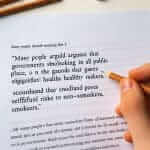“It is likely that” is a useful phrase to express probability and prediction in English, a skill often tested in the IELTS exam, particularly in the Writing and Speaking sections. Mastering its use can contribute to achieving a higher band score.
Here are some examples of how “it is likely that” can be used across different sections of the IELTS:
Writing Task 1:
- “It is likely that the demand for renewable energy sources will continue to rise in the coming years.” (This sentence predicts a future trend based on current data.)
Writing Task 2:
- “Some argue that globalization leads to cultural homogenization. However, it is likely that diverse cultural identities will persist, albeit with increased interconnectivity.” (This sentence presents a counter-argument while acknowledging the probability of the opposing view.)
Speaking Part 3:
- “Well, it is likely that artificial intelligence will play an even greater role in our lives in the future, impacting various industries and aspects of our daily routines.” (This sentence expresses a prediction about the future impact of technology.)
In each example, “it is likely that” introduces a statement about a probable future event or situation. This phrase allows for nuanced expression, indicating that while something is not certain, it holds a high degree of possibility.
Understanding “It is likely that”
“It is likely that” is used to express a high probability of something happening. It suggests that the speaker or writer believes that there is a strong chance of the event occurring.
Grammatical Structure and Usage
It + is/was + likely + that + subject + verb (present/future tense)
Example:
- It is likely that the government will introduce new policies to address climate change.
Breakdown:
- It: A dummy pronoun, holding the place of the actual subject (the government introducing new policies).
- is likely: The phrase indicating probability.
- that: A conjunction connecting the phrase to the following clause.
- the government will introduce new policies to address climate change: The clause describing the likely event.
Applications in IELTS
Writing Task 1: Describing Trends
Use “it is likely that” to make predictions about future trends based on the data provided in graphs, charts, or diagrams.
Example:
Given a graph showing a steady increase in online shopping over the past decade, you could write:
“Based on the current trend, it is likely that online shopping will continue to grow in popularity, potentially surpassing traditional retail methods.”
 Online Shopping Trend
Online Shopping Trend
Writing Task 2: Presenting Arguments
When presenting your stance on an issue, use “it is likely that” to introduce a probable outcome or consequence.
Example:
“While some believe that stricter regulations hinder economic growth, it is likely that they ultimately contribute to a more sustainable and equitable system in the long run.”
Speaking Part 3: Expressing Opinions
Use “it is likely that” when discussing your views on various topics, especially when making predictions about the future.
Example:
“Considering the rapid advancements in technology, it is likely that we will see significant changes in the job market, with automation potentially replacing certain roles.”
Achieving a Higher Band Score
Using “it is likely that” effectively demonstrates a strong command of grammatical structures and vocabulary related to probability. However, to further enhance your writing and speaking, consider incorporating these variations:
Synonyms and Alternatives:
- It is probable that…
- There is a high probability that…
- In all likelihood…
- It is highly likely that…
- The chances are that…
Advanced Usage:
- It seems increasingly likely that… (To emphasize a growing probability)
- While it is likely that…, it is also possible that… (To acknowledge other possibilities)
By incorporating these variations and expressing probability with nuance, you can showcase a wider range of vocabulary and grammatical structures, potentially leading to a higher band score.
Common Errors to Avoid
- Incorrect tense: Ensure the verb tense in the clause following “that” aligns with the time frame you are referring to.
- Overuse: While useful, avoid overusing “it is likely that.” Vary your language and explore alternative ways to express probability.
- Lack of support: Always provide reasons or evidence to support your statements of probability.
Conclusion
Mastering the use of “it is likely that” and its variations can be a valuable asset in your IELTS exam preparation. By understanding its grammatical structure, exploring its applications in different sections, and incorporating synonyms and advanced usage, you can effectively express probability, strengthen your arguments, and enhance the overall quality of your responses, ultimately boosting your chances of achieving your desired band score. Continue to practice using this phrase in various contexts related to IELTS topics, and aim to express probability with clarity and precision.


